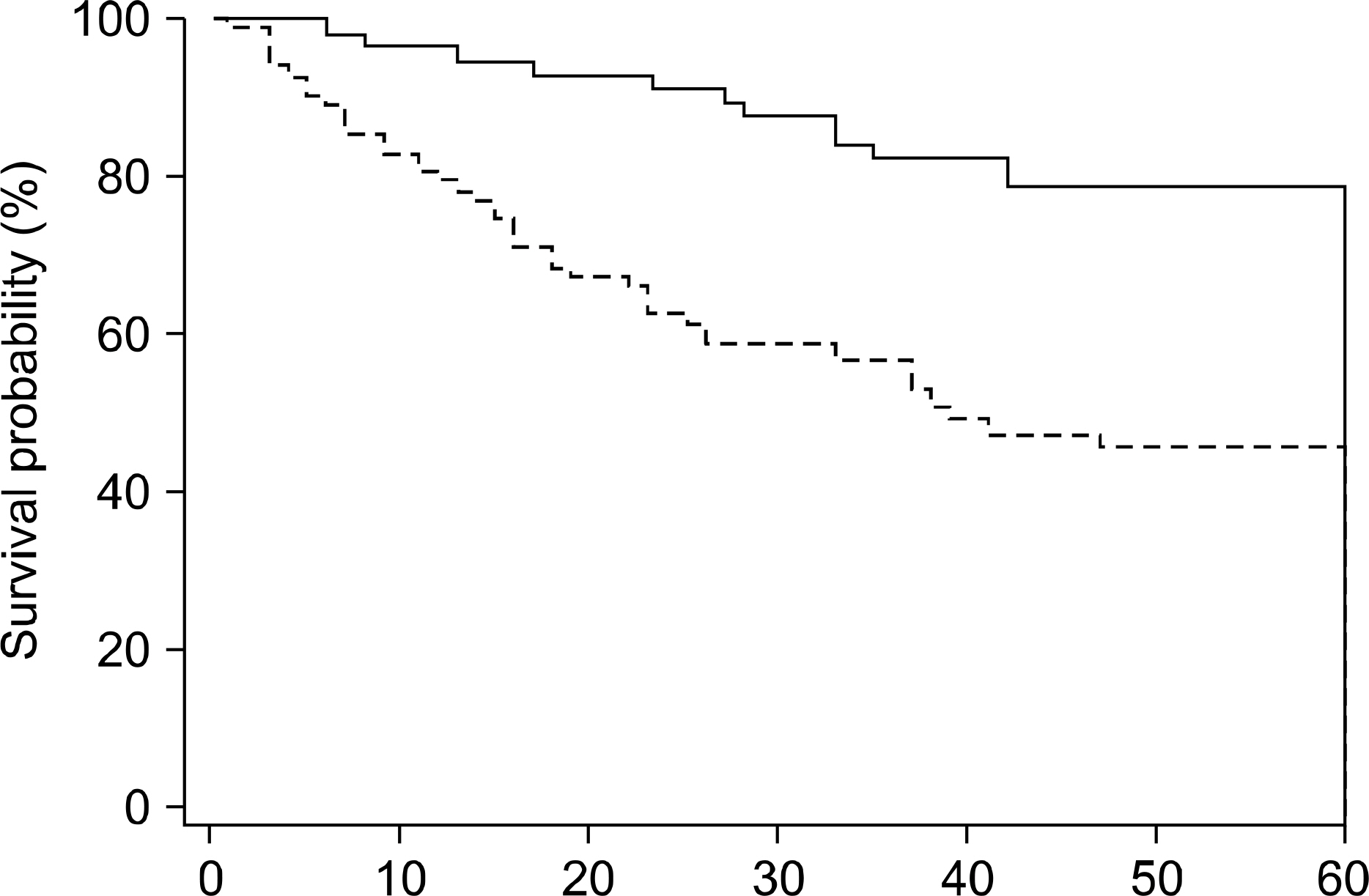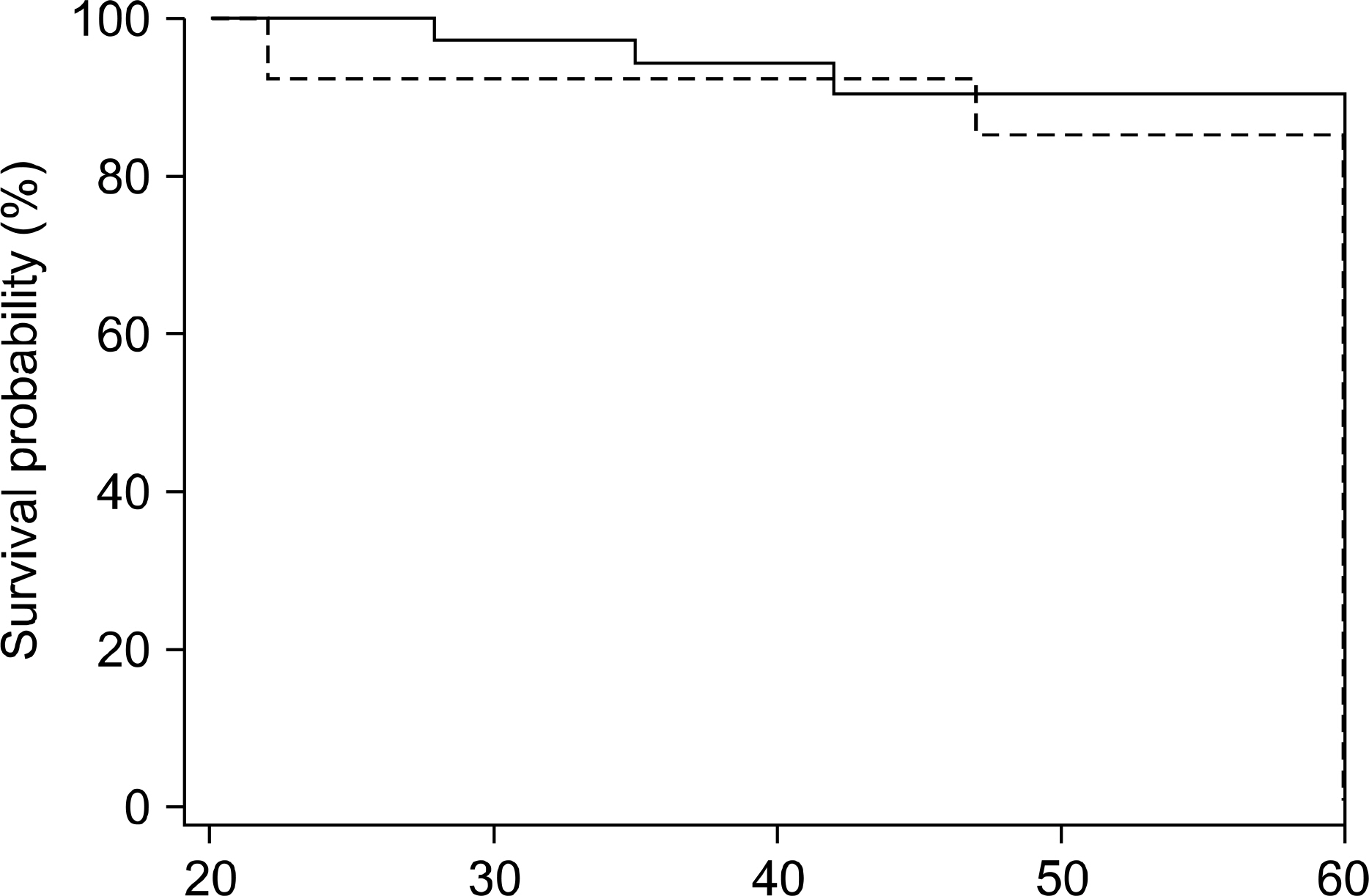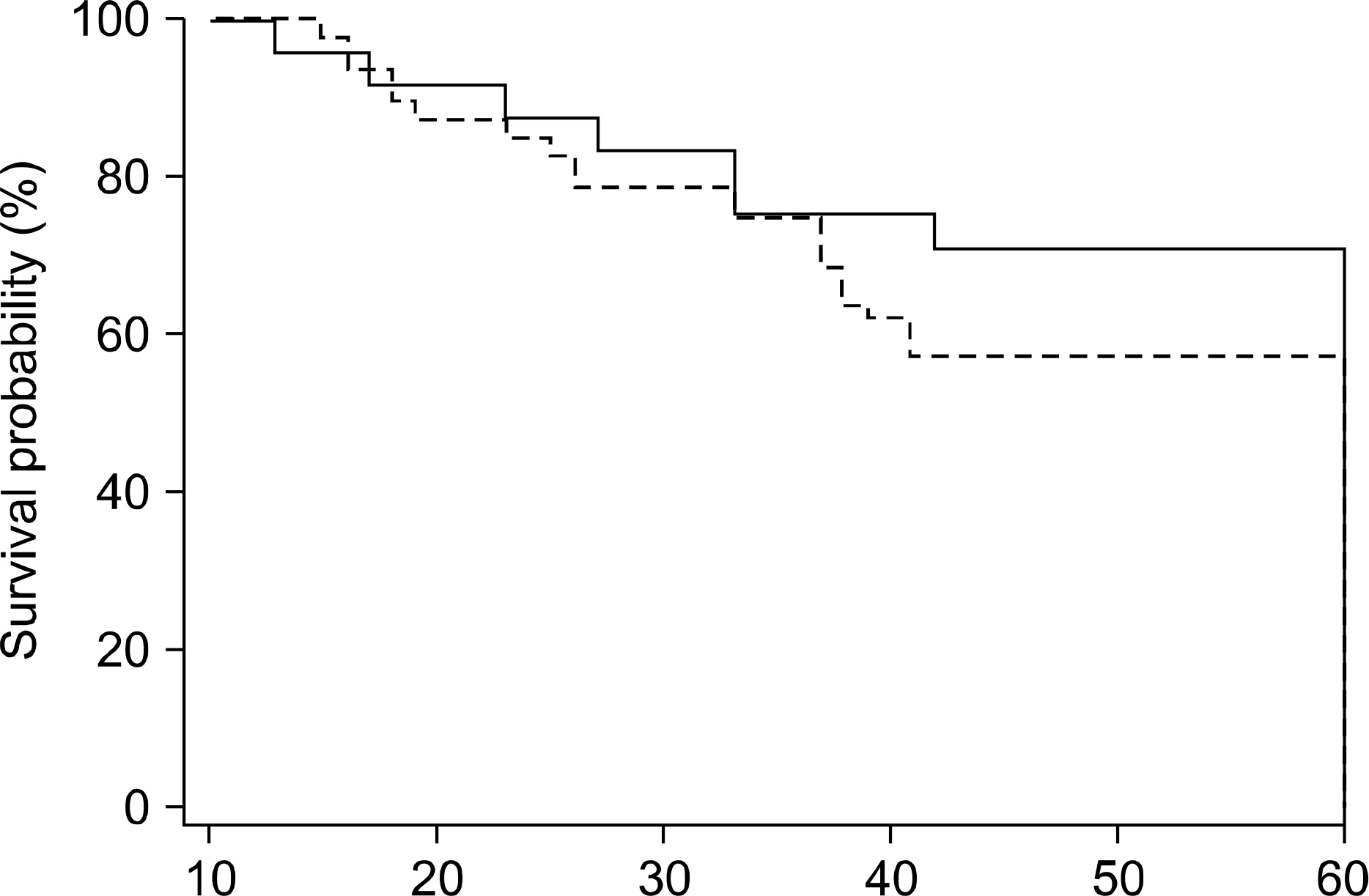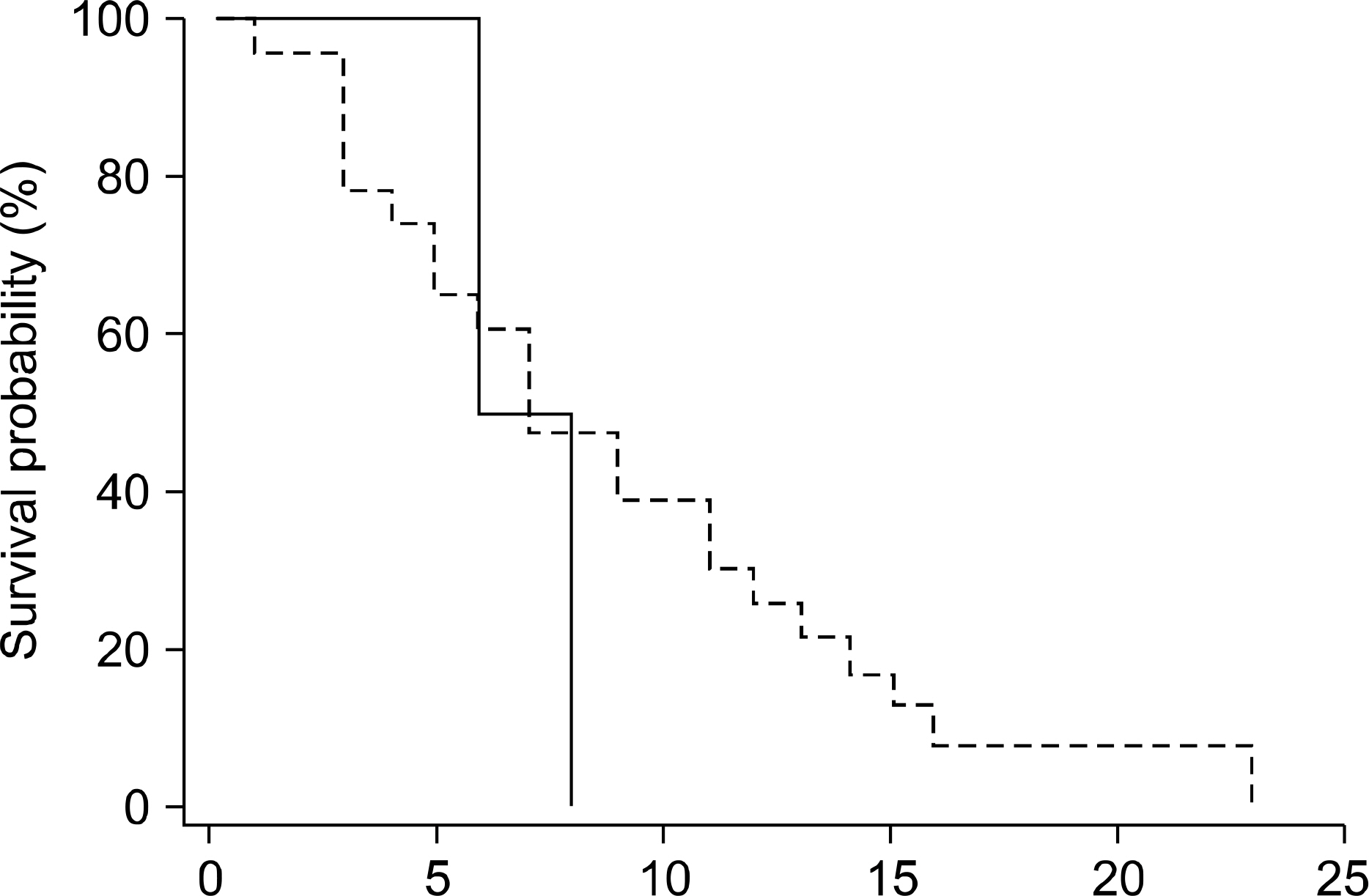Korean J Urol.
2008 Aug;49(8):675-681.
Characteristics of Incidentally Detected Renal Cell Carcinoma
- Affiliations
-
- 1Department of Urology, College of Medicine, Chung-Ang University, Seoul, Korea. kthlmk@hanafos.com
Abstract
-
PURPOSE: This study compared the clinicopathological features, diagnosis and prognosis of an incidental renal cell carcinoma with those of a symptomatic carcinoma.
MATERIALS AND METHODS
The medical records of 140 renal cell carcinoma patients at our hospital between 1995 and 2004 were reviewed. The patients were divided into two groups: asymptomatic and symptomatic patients. The patients characteristics, radiologic studies, tumor stage, tumor size, nuclear grade, and survival rates were investigated. The data was analyzed using a chi-square test, Student's t-test and Kaplan-Meier survival curve.
RESULTS
Of the 140 patients 57(41%) were asymptomatic and 83(59%) were symptomatic. The median tumor size was 5.2cm for incidental cancer and 8.1cm for symptomatic cancer. The 5-year cancer specific survival rate was significantly higher for the incidental tumors than the symptomatic tumors(78.9% versus 45.8%). When adjusted for stage, there was no difference in survival in those with stage I to IV disease between the 2 groups. Stage I, II lesions were present in 82.5% of patients in the incidental group and 39.7% in the symptomatic group. In contrast, a stage lesion was present in 17.5% of the patients in the incidental group compared with 60.3% in the symptomatic group. A higher tumor grade of symptomatic lesions was also noted.
CONCLUSIONS
The incidental group showed a significantly lower stage and grade, and a higher 5-year survival rate. This result was attributed to the early detection of renal cell carcinoma before the onset of symptoms. Overall, early detection of renal cell carcinoma using radiologic tools will improve the prognosis of renal cell carcinoma.
Keyword
Figure
Reference
-
1.Homma Y., Kawabe K., Kitamura T., Nishimura Y., Shinohara M., Kondo Y, et al. Increased incidental detection and reduced mortality in renal cancer-recent retrospective analysis at eight institutions. Int J Urol. 1995. 2:77–80.
Article2.Aso Y., Homma Y. A survey on incidental renal cell carcinoma in Japan. J Urol. 1992. 147:340–3.
Article3.Tsui KH., Shvarts O., Smith RB., Figlin R., de Kernion JB., Belldegrun A. Renal cell carcinoma: prognostic significance of incidentally detected tumors. J Urol. 2000. 163:426–30.
Article4.Greene FL., Page DL., Fleming ID. AJCC cancer staging manual. 6th ed.New York: Springer-Verlag;2002. 323-8.5.Boring CC., Squires TS., Tong T., Montgomery S. Cancer statistics, 1994. CA Cancer J Clin. 1994. 44:7–26.
Article6.Janzen NK., Kim HL., Figlin RA., Belldegrun AS. Surveillance after radical or partial nephrectomy for localized renal cell carcinoma and management of recurrent disease. Urol Clin North Am. 2003. 30:843–52.
Article7.Lee C., Lee ES., Choi H., Koh SK., Lee JM., Chai SE, et al. Incidence estimation of genitourinary cancer in Korea. J Korean Med Sci. 1992. 7:154–61.
Article8.Ministry of Health and Welfare. 2002 Annual Report of the Korea Central Cancer Registry (Published in 2003).9.Mevorach RA., Segal AJ., Tersegno ME., Frank IN. Renal cell carcinoma: incidental diagnosis and natural history: review of 235 cases. Urology. 1992. 39:519–22.
Article10.Jayson M., Sanders H. Increased incidence of serendipitously discovered renal cell carcinoma. Urology. 1998. 51:203–5.
Article11.Skinner DG., Colvin RB., Vermillion CD., Pfister RC., Leadbetter WF. Diagnosis and management of renal cell carcinoma. A clinical and pathologic study of 309 cases. Cancer. 1971. 28:1165–77.12.Ebert T., Owusu G., Strotmann P., Heydthausen M., Gerharz CD., Ackermann R. Do we need screening for renal cell carcinoma? J Urol. 1999. 161(Suppl):): 169, abstract 651.13.Frohmuller HG., Grups JW., Heller V. Comparative value of ultrasonography, computerized tomography, angiography and excretory urography in the staging of renal cell carcinoma. J Urol. 1987. 138:482–4.14.Ueda T., Mihara Y. Incidental detection of renal carcinoma during radiological imaging. Br J Urol. 1987. 59:513–5.
Article15.Michel F., Gattegno B., Lucacs B., Cohen L., Fiate PH., Thibault PH. Incidental discovery of renal carcinoma by ultrasonography. Presse Med. 1989. 18:671–4.16.Thompson IM., Peek M. Improvement in survival of patients with renal cell carcinoma-the role of the serendipitously detected tumor. J Urol. 1988. 140:487–90.
Article17.Rodriguez R., Fishman EK., Marshall FF. Differential diagnosis and evaluation of the incidentally discovered renal mass. Semin Urol Oncol. 1995. 13:246–53.18.Beisland C., Medby PC., Beisland HO. Renal cell carcinoma: gender difference in incidental detection and cancer-specific survival. Scand J Urol Nephrol. 2002. 36:414–8.
Article19.Siow WY., Yip SK., Ng LG., Tan PH., Cheng WS., Foo KT. Renal cell carcinoma: incidental detection and pathological staging. J R Coll Surg Edinb. 2000. 45:291–5.20.Ficarra V., Prayer-Galetti T., Novella G., Bratti E., Maffei N., Dal Bianco M, et al. Incidental detection beyond pathological factors as prognostic predictor of renal cell carcinoma. Eur Urol. 2003. 43:663–9.
Article21.Konnak JW., Grossman HB. Renal cell carcinoma as an incidental finding. J Urol. 1985. 134:1094–6.
Article
- Full Text Links
- Actions
-
Cited
- CITED
-
- Close
- Share
- Similar articles
-
- Clinical Characteristics of Incidentally Detected Renal Cell Carcinoma
- Clinical Characteristics of Incidentally Detected Renal Cell Carcinoma : Incidentaloma
- Clinical significance in incidentally detected renal cell carcinoma
- A Case of Papillary Type of Renal Cell Carcinoma after Renal Injury in a Child
- A Case of Renal Cell Carcinoma in Horseshoe Kidney





